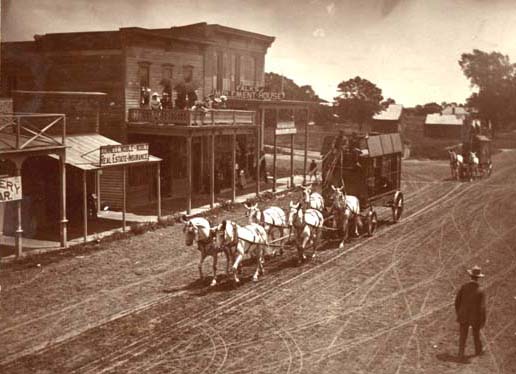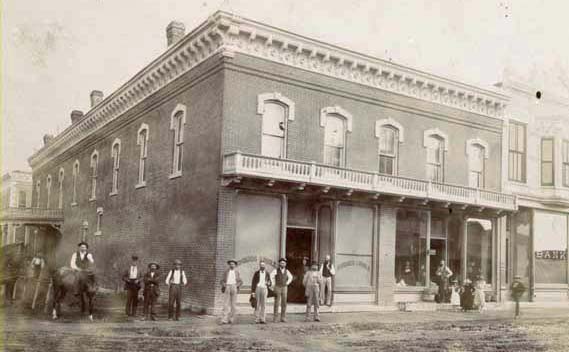Ninety-five years ago, on April 5, 1927, a tax-supported public library was created here in Kinsley. To celebrate this 95th birthday, you are invited to come by the library next Tuesday to have birthday cupcakes and coffee. We hope you’ll enjoy the library timeline on display in the foyer and on the website which records the many changes and events over the years.
The story begins in the early days of Kinsley when “club” or “church” libraries were organized by dedicated women who brought their education and culture to the prairie. These libraries were supported by fundraisers, donations, and charging a modest subscription fee to members for a “ticket”. Over the years, these libraries came and went, merged together and moved to various locations on main street.
The first, most prominent and consistent library among these was the Christian Endeavor Society (C.E.S.) library of the Congregational Church. Their library is recognized as the ancestor of the Kinsley Public Library. It was located in the church on Niles Ave., but anyone in the county could become a member and borrow books.

One different library was formed in 1886 by two young ladies from Wellington, KS. It was called the “The Franklin Square Library”. I imagine is was named after Benjamin Franklin, a great promoter of libraries. It was located in Mary (Mrs. C. W.) Beeler’s millinery shop at 110 E. Sixth St. (currently the vacant lot to the west of Country Tacs).
Early on, the topic of forming a free public library often came up in Kinsley. Establishing a public library “would fill a long-felt want and would be a saving to the rich, a God-send to the poor, and an honor to the promoters.” (Mercury, Oct. 3, 1887)
“Our merchants and real estate men should take hold of it because it is one of the best advertisements any city can have. And our people should take hold of it because it will keep the boys, to a great extent, at ‘home’ instead of frequenting the billiard halls every night which they now do.” (Mercury, Oct 8, 1887)
On election day, November 10, 1890, the Congregational ladies held an election day supper to support their library fund. The Mercury noted that the food would be good as the ladies have a “high reputation as culinary artists.” (Note that 132 years later, the Congregational ladies’ still carry on the tradition of a delicious luncheon on election day.)
The libraries seem to have languished in the early 1890s. In 1895 the Mercury reported that the Christian Endeavorites were reorganizing the library. They moved it to Mrs. Slingerland’s millinery shop, a grey-frame, two-story building located at 210 E. Sixth St. (currently the vacant lot on the west side of the Edwards County Extension Office).
Often fund-raising socials were held where people could donate a book or money to buy a book. It cost $1 to have a “ticket” to the library.

Slingerland sold the Millinery Bazaar in August, 1897 to the Schnatterly sisters, Morton and Myrton. They took on the duties of librarians in 1904 and the C. E. S. donated their books for a core collection.
In 1906, the C.E.S. also added its 250 volume Sunday School library into the Millinery Bazaar, which “was an excellent thing to do as everything that increases the number of good books in circulation in Kinsley diminishes to a degree the amount of loafing in undesirable places.”

The library remained in the Millinery Bazaar until the sisters sold it in 1910 after Morton’s marriage to the organist, Donald Seymour.
The library was closed until 1912 when the C.E.S. and the Friday Nite Club agreed to support the library together. Edwards, Noble and Co. offered to house the library in the NE corner of the second-floor of their building at 125 E. Sixth St. (currently Circle K Auto Parts). It had a collection of 2,080 volumes. Margaret Hills was hired as the librarian.

Later the Wednesday Evening Club took on the responsibility of the library. They put on the communities first Shakespearean play, “A Midsummer Night’s Dream” that August as a fundraiser for the library.
The desire for a free public library continued. In 1914, a plan was formed to combine the various semi-public libraries into one Kinsley Library Association. Ladies representing the different organizations raised funds and purchased two lots on the SW corner of Niles and Fifth St. with plans to build a library.
In 1917, Kinsley made application to Andrew Carnegie to build a library. Due to the U.S. entering WWI, all requests were turned down that year. Besides the war, 1917 also marked a failed wheat crop and an outbreak of measles which also contributed to setting aside the plans to build a library. As it turned out, 1916 was the last year Carnegie libraries were built as Andrew Carnegie died in 1919.
The library remained in the Edwards, Noble & Co Building until 1923. Now we are getting close to the 1927 birthday year, and I will pick up the story again next week.
